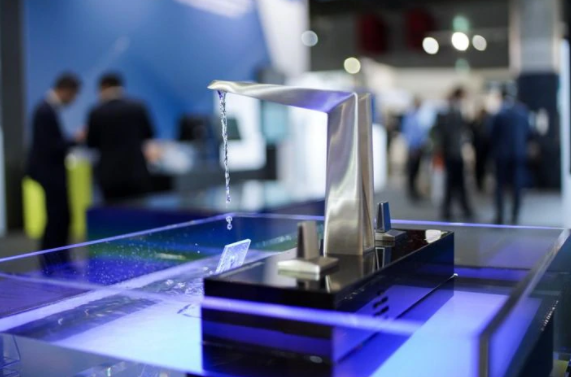Customized design – produced in series: GROHE is ushering in a new era in fittings’ production with 3D metal printing: By Trumpf
At the ISH 2019, the world’s leading trade fair for water, heating, and air conditioning, GROHE presented two fittings manufactured by 3D metal printing as the first of the leading sanitary ware brands in Europe. To do so, GROHE collaborated with TRUMPF to develop the 3D technology further – ushering in a new era in fittings’ production, in which customization and freedom in design play the starring roles. GROHE Icon 3D fittings are manufactured at the LIXIL EMENA production site in Hemer with the TruPrint 3000 in laser metal fusion (LMF) processes.
As well as the fittings, additive manufacturing opens up completely new opportunities for GROHE in prototype production and tool manufacturing for zinc and plastic injection molding for interior cooling channels.
Challenge
The main challenge in developing customized and innovative fittings’ designs was to preserve the quality for which GROHE is known worldwide and to implement it in a 3D metal print product. The focus was to maintain water purity, meaning that the powder material used must comply with the drinking water ordinance and must be appropriately qualified for additive manufacturing. Furthermore, thermal deformation must be taken into consideration even before manufacturing. In addition, any post-processing that could be required must be reduced to a minimum due to the high surface requirements.
Solution
GROHE’s design and development team has looked very closely at 3D metal printing for many years and has built up a great deal of expertise in technology and material qualification. In January 2018, they finally decided on two of the TRUMPF TruPrint 3000 medium-format machines. To develop the bathroom fittings, they developed their own procedure with a specific formula for the metal powder qualified for the brand. GROHE acquired their own patents in view of the drinking water ordinance required.
“We are stepping into the future of product design with GROHE Icon 3D as we can now create designs that do not seem attainable at first.”
PAUL FLOWERSCHIEF DESIGN OFFICER LIXIL
Implementation
The two designs of the GROHE Icon 3D fittings are produced in small series with a machine runtime of 6,000 hours a year; to do so, the TruPrint 3000 runs at full capacity in three-shift operation. There is room for two fittings in the TruPrint 3000 in each printing process; they are built up in approximately 4,700 layers, each layer 0.06 mm thick, made of stainless steel or a brass alloy.
The walls are 1 to 1.5 mm thick; the melting point is a minimum of 1400 °C. After printing, the component is mechanically processed on a CNC milling machine. Then the manual sanding and fine brushing processes are carried out as the final steps in surface finishing. While a conventional manufacturing process requires 4.5 months from the design of the water equipment to component assembly, all development and manufacturing steps required for 3D printing can be carried out in just 52 hours.
Forecast
The 3D metal printing procedure initiates a change in the thinking of GROHE in relation to product development and manufacturing. It means designs can be reimagined and customization requests can be implemented efficiently for architectural projects, for example. Additive manufacturing is also interesting in terms of sustainability: the resource-friendly method only uses as much material as it actually needs.
Components such as drains and grips can be manufactured so that they are significantly thinner, therefore saving material. There is a weight reduction of approximately 55% with the 3D print variant of the GROHE Allure Brilliant fitting compared to its similar predecessor in brass. “The ‘additive spark’ is catching fire throughout the entire organization at the moment”, says Thorsten Schollenberger, Vice President of Industrial Engineering, EHS & Sustainability, at GROHE. Schollenberger reports that there are several workshops at GROHE aimed at finding new products and applications which can be printed on the basis of new materials. He also says that the brand has similar projects in place to utilize 3D printing for tool manufacturing.
This content was originally published on the Trumpf website.


 “We are stepping into the future of product design with GROHE Icon 3D as we can now create designs that do not seem attainable at first.”
“We are stepping into the future of product design with GROHE Icon 3D as we can now create designs that do not seem attainable at first.”